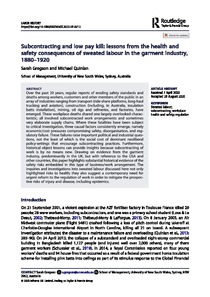Subcontracting and low pay kill: lessons from the health and safety consequences of sweated labour in the garment industry, 1880-1920

Gregson, Sarah ; Quinlan, Michael
2020
Early View
1-17
occupational safety and health ; unsafe working conditions ; textile industry ; outsourcing ; history
Occupational safety and health
https://doi.org/10.1080/0023656X.2020.1818712
English
Bibliogr.
"Over the past 20 years, regular reports of eroding safety standards and deaths among workers, customers and other members of the public in an array of industries ranging from transport (ride-share platforms, long-haul trucking and aviation), construction (including, in Australia, insulation batts installation), mining, oil rigs and refineries, and factories, have emerged. These workplace deaths shared one largely overlooked characteristic; all involved subcontracted work arrangements and sometimes very elaborate supply chains. Where these fatalities have been subject to critical investigation, three causal factors consistently emerge, namely economic/cost pressures compromising safety, disorganisation, and regulatory failure. These failures raise important political and industrial questions, not the least of which is the social cost of dominant neoliberal policy-settings that encourage subcontracting practices. Furthermore, historical object lessons can provide insights because subcontracting of work is by no means new. Drawing on evidence from the garment industry, predominantly in the UK, but with reference to the USA and other countries, this paper highlights substantial historical evidence of the safety risks embedded in this type of business/work arrangement. The inquiries and investigations into sweated labour discussed here not only highlighted risks to health; they also suggest a contemporary need for urgent reform to the regulation of work in order to mitigate the prospective risks of injury and disease, including epidemics."
Digital
The ETUI is co-funded by the European Union. Views and opinions expressed are however those of the author(s) only and do not necessarily reflect those of the European Union or the ETUI.